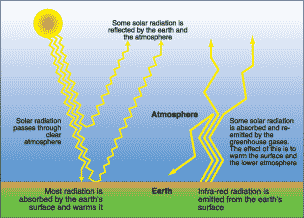






       |
||
|
http://www.sprep.org |
||
 Heat
from the sun passes through the atmosphere and warms the surface of the Earth.
Some of this heat is reflected back into outer space through the atmosphere
and some is retained, just like in a greenhouse. It is this balance of absorption
and reflection, known as the greenhouse effect, that has kept the Earth's temperature
stable for eons. Over billions of years the Earth has developed a system that
can absorb and recycle the gases produced by natural process like plant and
animal respiration, volcanic eruptions and forest fires.
Heat
from the sun passes through the atmosphere and warms the surface of the Earth.
Some of this heat is reflected back into outer space through the atmosphere
and some is retained, just like in a greenhouse. It is this balance of absorption
and reflection, known as the greenhouse effect, that has kept the Earth's temperature
stable for eons. Over billions of years the Earth has developed a system that
can absorb and recycle the gases produced by natural process like plant and
animal respiration, volcanic eruptions and forest fires.
As oil and coal are burned the carbon they contain combines with oxygen in
the air to give off heat and produce carbon dioxide, and other gases. As population
increases and development spreads, more and more energy is being used and ever-increasing
volumes of carbon dioxide are being generated. Since 1750, when written records
were first kept, the global concentration of carbon dioxide has increased by
about 30%. Emissions of methane and nitrous oxide, from fuel consumption, converting
forest to farmland, cultivation and fertilization of soils, production of ruminant
livestock and management of livestock manure, have increased by roughly 131%
and 17% in 250 years. However, carbon dioxide is the main greenhouse gas.
The amounts of greenhouse gases that are being produced have exceeded the Earth's
ability to absorb them and they are accumulating in the atmosphere. As they
build up they trap more and more heat from the sun inside the atmosphere. It
is generally accepted that this build up is one of the primary causes of an
increase in the average temperature of the Earth, which will eventually cause
significant changes in the Earth’s climate.
One of the greatest challenges to sustainable development in the 21st century
is climate change. Climate change is a change in the "average weather" that
a region experiences. By increasing the amount of heat-trapping gases released,
humankind has enhanced the warming capability of the natural greenhouse effect.
It is the human-induced enhanced greenhouse effect that causes environmental
concern.
The Intergovernmental Panel on Climate Change projects that unless drastic
action is taken, global temperatures will continue to rise and extreme events
will become more frequent and intense. Most governments in the world are making
efforts to reduce the production of greenhouse gases, even though fossil fuels
will remain the mainstay of energy production well into the 21st century and
agriculture must produce more and more food. Governments are also looking for
ways to remove the excess carbon dioxide that is already in the atmosphere,
but the amounts are so huge this may not be practical. This has serious implications
for the fragile and vulnerable islands of the Pacific, already witnessing the
negative impacts of climate change as sea levels rise.
Many Pacific islands are extremely vulnerable to climate change, climate variability,
and sea level rise and will be among the first to suffer the impacts of climate
change and among the first to be forced to adapt or abandon or relocate from
their environment. The islands are low lying or have coastal features and characteristics
that make them particularly vulnerable to climate change, variability and sea
level change. In addition to significant coastal impacts climate change will
affect biodiversity, soils and the water supplies of small islands. Most small
island states will find it extremely difficult to adaptation to these changing
conditions. The impacts will be felt for many generations because of the small
island states’ low adaptive capacity, high sensitivity to external shocks
and high vulnerability to natural disasters.
Failure to adapt to climate change now could lead to high social and economic
costs in the future. For the low lying atolls, the economic disruption could
be catastrophic, even to the extent of requiring population relocation into
other islands or increasing the number of people emigrating from the islands.
Some areas of coral reefs, may be so enfeebled by overfishing that they may
not be able to recover from bleaching events in the future. Public pressure
is mounting for action on adaptation. There is growing community and government
concern about the need to reduce the islands' vulnerability and manage the
risks posed by extreme events and long-term change.